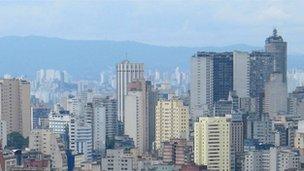Megacities face delicate balancing act
- Published

Hundreds of skyscrapers make up Shanghai's skyline
One of the most striking developments of the last century has been the growth of cities. A hundred years ago, 20% of us lived in cities.
Now it is more than half of a much larger population.
At the same time, the size of the biggest cities has climbed. There is even a word for the very biggest, the megacity, sometimes defined as an urban area with a population of more than ten million.
There are a few in rich nations, including Tokyo, (with more than thirty million people), New York, Los Angeles and London.
But most are in emerging and developing countries, especially in Asia. Several have populations of well over twenty million and they certainly have their challenges.
A city out of control - that is the image that some of the vast conurbations of the developing world have acquired, says Saskia Sassen, Professor of Sociology at Columbia University in New York.
But it's probably not the reality she says.
That is not because of governments, but the result of the hard work of the residents.
She told the BBC: "They make an economy, they make their housing, and they make an informal governance system".
For example, Biola Ajaga, a single mother in Nigeria's megacity, Lagos, told the BBC that where she lives everyone pays a fee to a vigilante group to keep the peace.
Better life
Which raises the question, if the basics aren't there, why on earth do these giant cities continue to act as a magnet for such vast numbers of people?
Prof Sassen gives three main reasons.

Singapore's controlled urban development has placed it at the forefront of city planning
First, the desperate situation of many people in rural areas, who move to cities in the hope of a better life.
Then she says there is the fact that 220 million hectares of land have been bought by foreign buyers in the last five years - foreign governments and businesses. She says many people are evicted as result.
And then there is desertification. There are whole areas of India for example where the ground water has gone, she says, places where if you have a well it will not give you water.
But there are some factors that discourage people, such as when a city becomes so big so that you can't live anywhere near where the jobs are.
She says that Sao Paulo in Brazil and Mexico City have not grown as large as some expected. That kind of balancing mechanism might be the reason.

Sao Paulo has not grown as big as many expected
Megacities on such a vast scale are a modern phenomenon.
But the ancient world had its big cities with real challenges, and some of them that sound every bit as difficult as their modern equivalents.
Dr Armand D'Angour, who teaches classics at Oxford University, describes the satirist Juvenal writing about Rome two thousand years ago, as a place of constant noise and traffic, with garbage and sewage thrown into the street and dangers of violence and sudden death.
Babylon in what is now Iraq had a problem that is harder to imagine being repeated today.
Dr D'Angour says that "the sheer extent of the city's territory had left some regions unaware of enemy incursion for three days, thus preventing the Babylonians from successfully defending themselves against the invaders".
You can hear more on this in the BBC World Service Radio programme Business Daily.
- Published29 January 2012
- Published12 July 2011
- Published21 June 2011